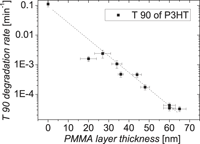Crossref Citations
This article has been cited by the following publications. This list is generated based on data provided by
Crossref.
Yousefi, Ali Akbar
2019.
Polythiophene coated poly(methyl methacrylate) sheet as a new candidate for flexible organic electrode applications.
SN Applied Sciences,
Vol. 1,
Issue. 5,
Turkovic, Vida
Prete, Michela
Bregnhøj, Mikkel
Inasaridze, Liana
Volyniuk, Dmytro
Obrezkov, Filipp A.
Grazulevicius, Juozas Vidas
Engmann, Sebastian
Rubahn, Horst-Günter
Troshin, Pavel A.
Ogilby, Peter R.
and
Madsen, Morten
2019.
Biomimetic Approach to Inhibition of Photooxidation in Organic Solar Cells Using Beta-Carotene as an Additive.
ACS Applied Materials & Interfaces,
Vol. 11,
Issue. 44,
p.
41570.
Channa, Iftikhar Ahmed
Distler, Andreas
Zaiser, Michael
Brabec, Christoph J.
and
Egelhaaf, Hans‐Joachim
2019.
Thin Film Encapsulation of Organic Solar Cells by Direct Deposition of Polysilazanes from Solution.
Advanced Energy Materials,
Vol. 9,
Issue. 26,
Zhang, Andi
Chen, Yujie
Wu, Zeru
Zhang, Shuailong
Zhu, Zhaoxiang
He, Lin
Liu, Lin
Zhang, Yanfeng
and
Yu, Siyuan
2019.
Enhanced amplified spontaneous emission from conjugated light-emitting polymer integrated with silicon nitride grating structures.
OSA Continuum,
Vol. 2,
Issue. 10,
p.
2875.
Ashok Kumar, Sangeetha
Gouthaman, Siddan
Shankar, Jaya Seeli
Periyasamy, Bhuvana K.
and
Nayak, Sanjay K.
2021.
Stable and color tunable MEH-PPV/PMMA polymer blends for light-emitting applications.
Chemical Physics Letters,
Vol. 770,
Issue. ,
p.
138462.
Channa, Iftikhar Ahmed
Distler, Andreas
Brabec, Christoph J.
and
Egelhaaf, Hans-Joachim
2021.
Organic Flexible Electronics.
p.
249.
Zhou, Guigang
Sun, Rui
Xiao, Yan
Abbas, Ghulam
and
Peng, Zhengchun
2021.
A High‐Performance Flexible Broadband Photodetector Based on Graphene–PTAA–Perovskite Heterojunctions.
Advanced Electronic Materials,
Vol. 7,
Issue. 3,
Adebayo, Adedayo S.
and
Osundiya, James Rotimi
2022.
Numerical modeling of strain hardening effect on an AFM cantilever undergoing stress in tapping mode.
Nano Select,
Vol. 3,
Issue. 3,
p.
703.
Treib, Caroline
Loos, Klara
Johlitz, Michael
and
Lion, Alexander
2022.
Ozone ageing: experimental methods on pristine and protected natural rubber.
Continuum Mechanics and Thermodynamics,
Vol. 34,
Issue. 6,
p.
1563.
Das, Bikash
Dolui, Kapildeb
Paramanik, Rahul
Kundu, Tanima
Maity, Sujan
Ghosh, Anudeepa
Palit, Mainak
and
Datta, Subhadeep
2023.
Ultrahigh breakdown current density of van der Waals one dimensional PdBr2.
Applied Physics Letters,
Vol. 122,
Issue. 26,
Lira Mario, M.
and
Casado Fanny, L.
2023.
Design and in silico validation of a human body on a chip for toxicity assessment of drugs to prevent graft-versus-host disease.
p.
489.
van der Pol, Tom P. A.
van Gorkom, Bas T.
van Geel, Wietse F. M.
Littmann, Jibbe
Wienk, Martijn M.
and
Janssen, René A. J.
2023.
Origin, Nature, and Location of Defects in PM6:Y6 Organic Solar Cells.
Advanced Energy Materials,
Vol. 13,
Issue. 12,
Smith, Melissa A.
Kalana, U. L. D. Inush
Sterbinsky, George E.
Wu, Tianpin
Kiesewetter, Matthew K.
and
Hayes, Dugan
2024.
Determining sulfur speciation in oxidatively crosslinked degradable polymers using sulfur K‐edge X‐ray absorption spectroscopy.
Journal of Polymer Science,
Vol. 62,
Issue. 18,
p.
4315.




